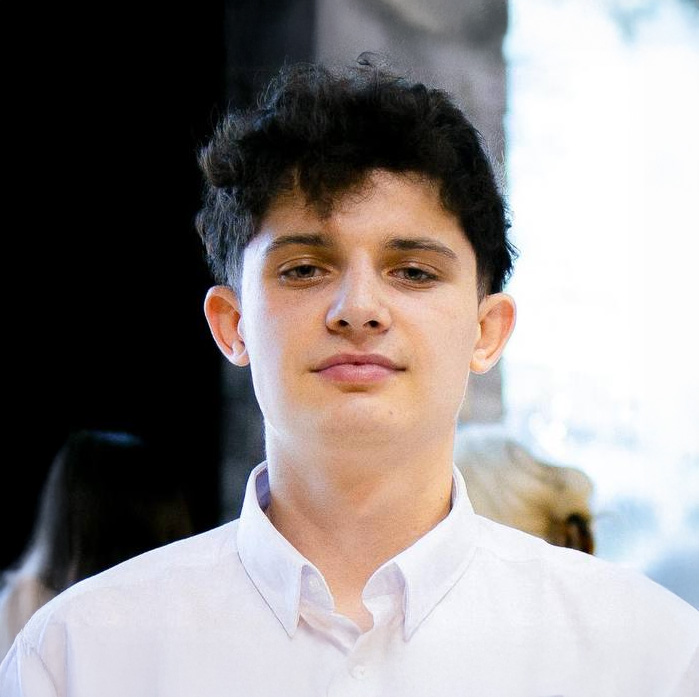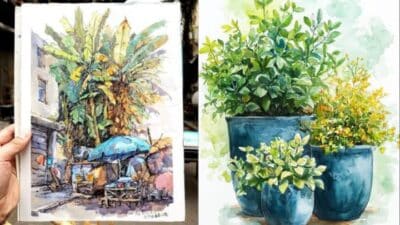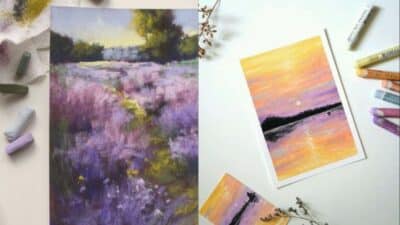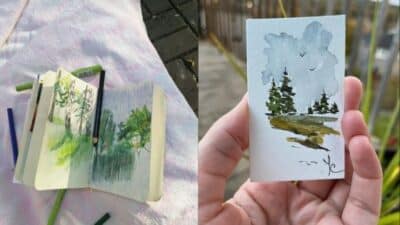Urban landscape sketching transforms busy city scenes into compelling artwork through quick, observational drawing techniques. This portable art form allows you to capture the energy and character of metropolitan environments using simple tools like pens, pencils, and watercolors. Whether you’re sketching from a café window or standing on a bustling street corner, urban sketching connects you directly with your surroundings.
Mastering urban landscape sketching requires understanding fundamental techniques like loose line work, selective detail, and efficient composition strategies that help you work quickly in dynamic environments. The key lies in learning to see beyond individual elements and instead focus on the overall shapes, values, and relationships that define urban spaces.
This comprehensive guide will walk you through everything from selecting the right materials to developing your personal sketching style. You’ll discover how to approach complex cityscapes with confidence, apply watercolor techniques effectively, and connect with a growing community of urban sketchers who share your passion for capturing city life through art.
Key Takeaways
- Urban landscape sketching captures city life through quick, on-location drawings using portable materials and efficient techniques
- Success depends on mastering loose line work, selective detail, and composition strategies rather than trying to draw everything perfectly
- Building skills through practice and community connection enhances both technique and enjoyment of this accessible art form
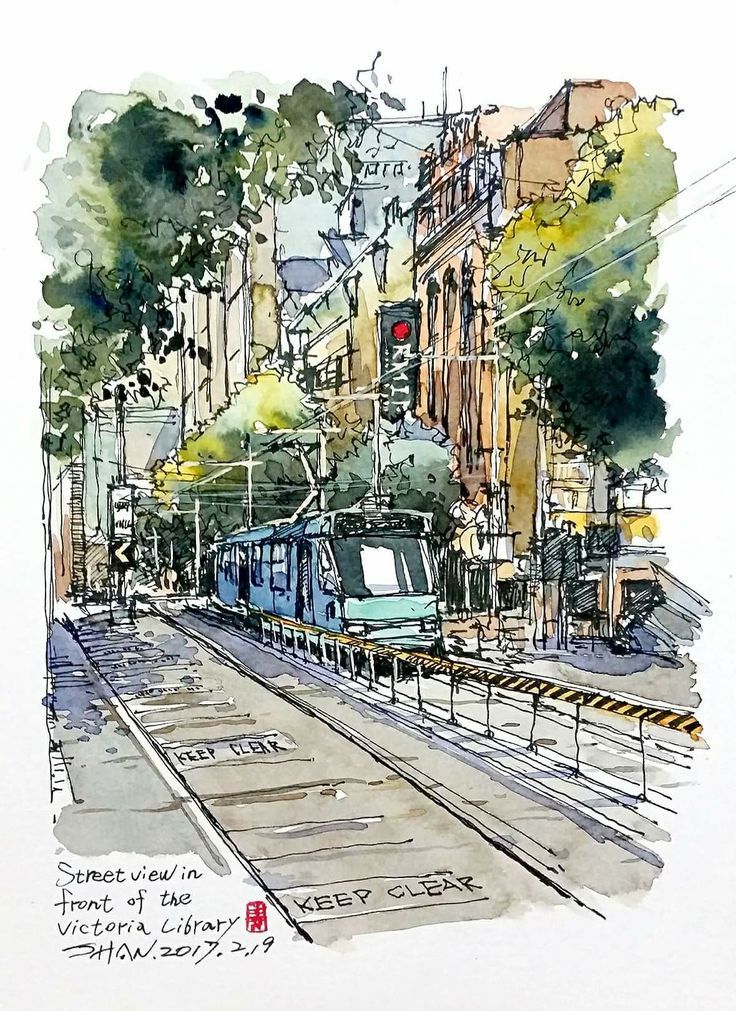
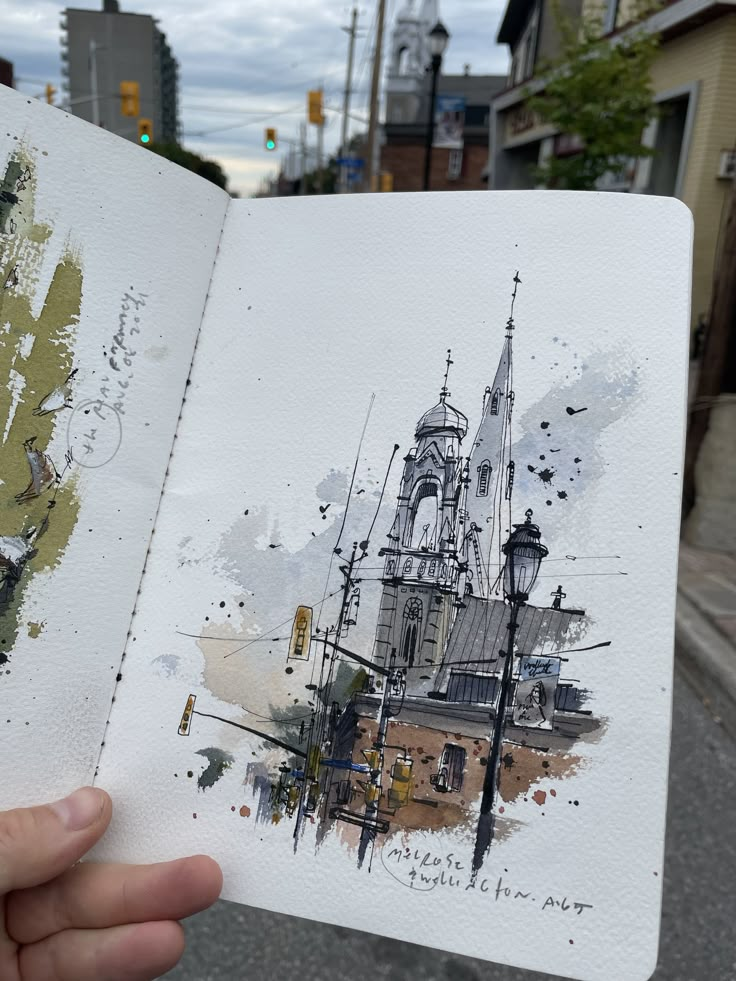
Understanding Urban Landscape Sketching
Urban landscape sketching centers on capturing architectural elements and cityscapes through direct observation. This practice emphasizes spontaneous drawing in public spaces while documenting the built environment around you.
What Defines Urban Landscape Sketching
Urban landscape sketching focuses on drawing buildings, streets, and architectural features within city environments. You create these sketches by observing real urban scenes rather than working from photographs or imagination.
Key characteristics include:
- Drawing buildings, bridges, and street infrastructure
- Capturing architectural proportions and details
- Documenting cityscapes and urban environments
- Creating sketches that reflect metropolitan life
Your urban sketches serve as visual records of specific places and moments. The practice emphasizes accuracy in representing architectural elements while maintaining artistic expression.
Urban sketchers typically work with portable materials that allow quick setup and movement. You focus on capturing the essential character of urban spaces through line, form, and sometimes color.
The Role of On-Location Observation
On-location observation forms the foundation of urban landscape sketching. You must position yourself directly in the environment you plan to sketch, whether on busy streets or quiet urban corners.
This direct observation allows you to notice details that photographs cannot capture. You experience the scale, atmosphere, and context of buildings and urban spaces firsthand.
Benefits of on-location work:
- Accurate proportional relationships
- Real-time lighting conditions
- Authentic environmental context
- Immediate sensory experience
Your sketches gain authenticity through this direct engagement with urban environments. You develop stronger observational skills by constantly analyzing architectural forms and spatial relationships.
Differences from Other Sketching Practices
Urban landscape sketching differs significantly from studio-based or nature sketching practices. You work within time constraints imposed by public spaces and changing urban conditions.
Key distinctions:
| Urban Sketching | Studio Sketching | Nature Sketching |
|---|---|---|
| Public locations | Controlled environment | Natural settings |
| Architectural subjects | Various subjects | Organic forms |
| Time limitations | Extended time | Weather dependent |
| Portable materials | Full art supplies | Outdoor-ready tools |
Your urban sketches require quick decision-making about composition and detail level. You must adapt to crowds, noise, and urban distractions while maintaining focus on architectural accuracy.
The spontaneous nature of urban sketching creates a different artistic outcome than planned studio work. You capture the immediate energy and character of city life through rapid, observational drawing techniques.
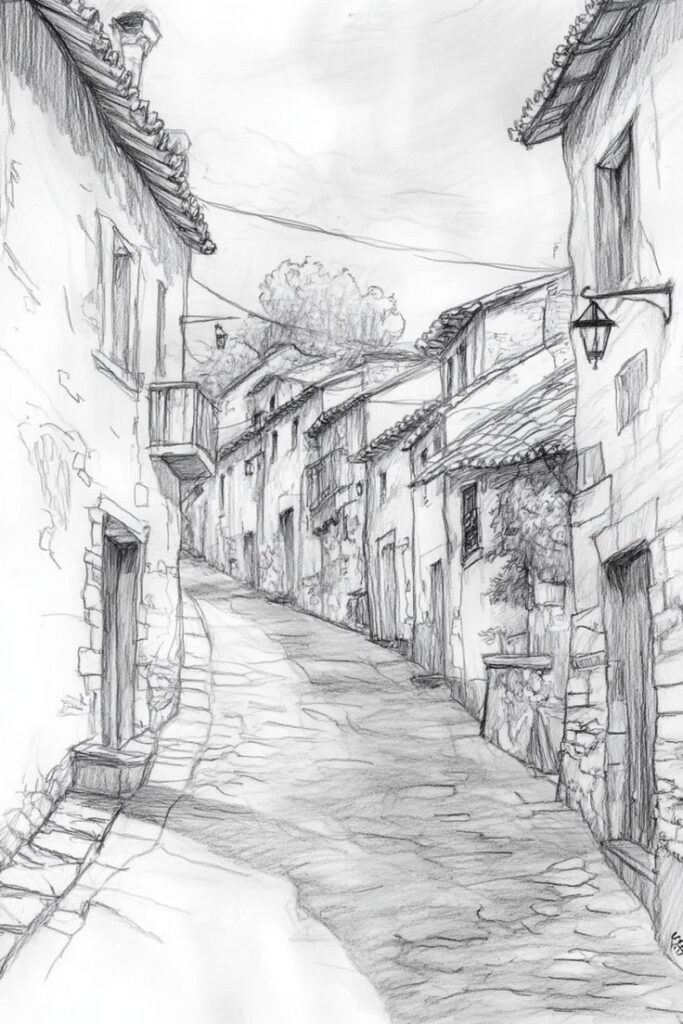
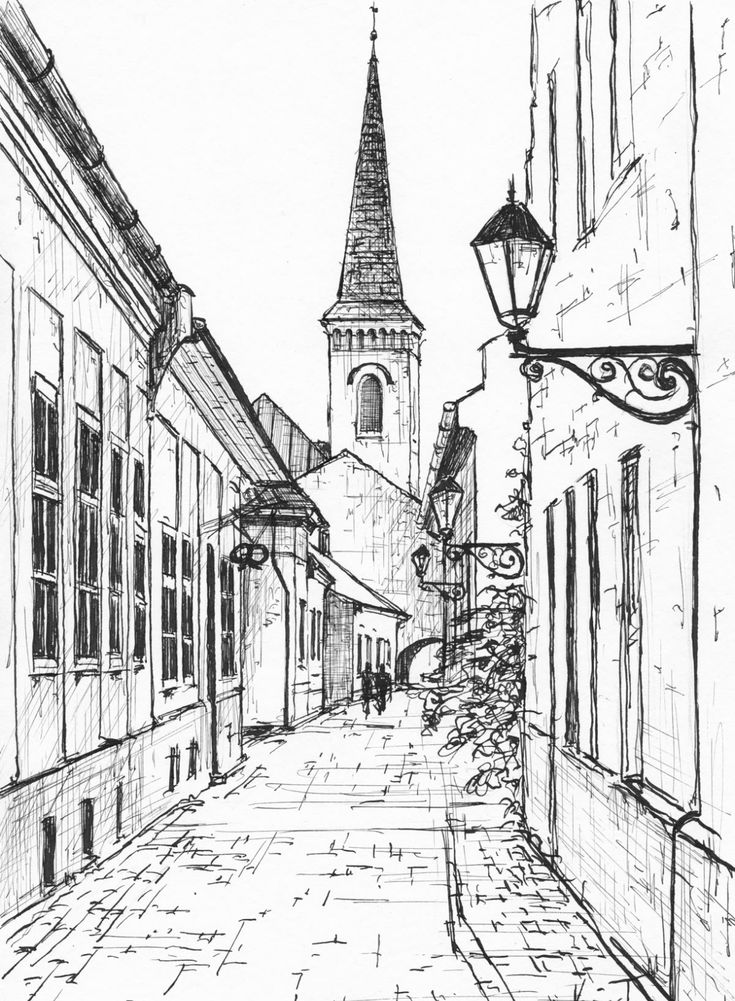
Essential Materials and Art Supplies
The success of your urban landscape sketching depends on selecting the right materials that work well outdoors and can capture cityscapes quickly. Sketchbooks, ink pens, and watercolors form the foundation of most urban sketching kits, while additional tools enhance your ability to document architectural details and atmospheric effects.
Choosing the Right Sketchbook
Your sketchbook serves as the foundation for all urban sketching work. Look for paper that weighs at least 140gsm to handle both dry and wet media without warping.
Mixed media paper works best for urban sketching since it accepts pencil, ink, and watercolors equally well. Hot-pressed watercolor paper provides smooth surfaces ideal for detailed architectural work.
Size matters when sketching on location. A5 or A4 formats offer enough space for detailed cityscapes while remaining portable. Hardbound books protect your work better than spiral-bound options.
Consider paper texture based on your preferred techniques. Smooth paper suits fine line work and architectural details. Textured paper adds character to loose, expressive sketches.
Selecting Ink Pens and Watercolors
Ink pens provide permanent lines that won’t smudge when you add watercolor washes. Pigment-based pens offer better lightfastness than dye-based alternatives.
Fine-tip pens ranging from 0.3mm to 0.8mm work well for architectural details. Brush pens add expressive line variation for foreground elements and organic shapes.
Watercolor paints in tubes or pans both work for urban sketching. Tubes offer more intense color mixing but require palettes. Pans provide convenience and portability.
Essential colors include ultramarine blue, burnt umber, yellow ochre, and alizarin crimson. These four colors mix to create most urban landscape needs.
Travel watercolor sets with built-in mixing areas streamline your setup. Look for sets with at least 12 colors for adequate range.
Other Tools for Urban Landscape Sketching
Water containers and brushes complete your basic art supplies kit. Collapsible water containers save space and prevent spills during transport.
Round brushes in sizes 6, 10, and 14 handle most urban sketching needs. Synthetic brushes work well with watercolors and clean easily.
Pencils help establish proportions before adding ink. 2B or 4B pencils provide sufficient darkness without being too soft for outdoor use.
Small sponges or paper towels control water and lift paint for cloud effects. Masking tape protects clean edges when needed.
A portable stool or folding chair lets you work comfortably for extended periods. This becomes essential for detailed architectural studies.
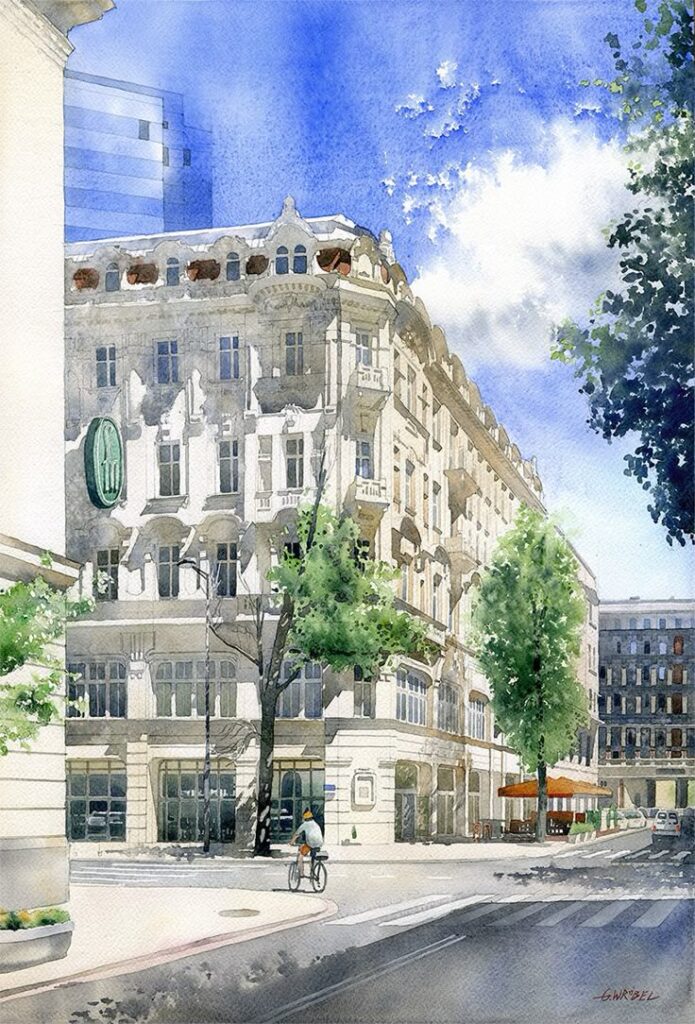
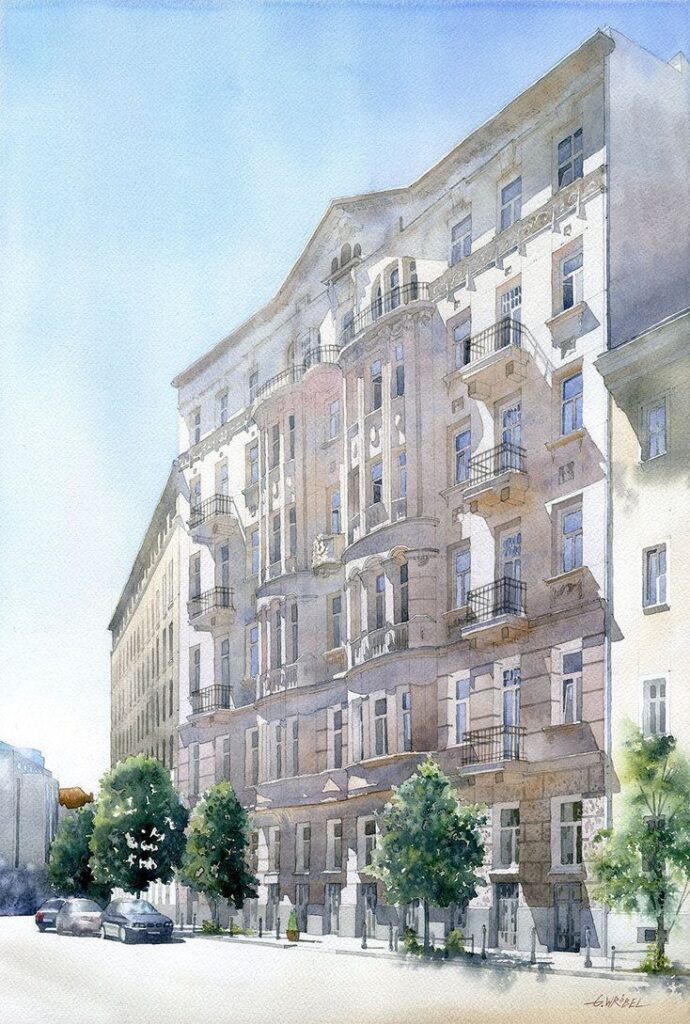
Core Urban Landscape Sketching Techniques
These fundamental techniques form the foundation of effective urban sketching, from establishing basic forms through line work to adding depth with hatching and capturing the dynamic energy of city life through movement and lighting.
Line Drawing and Outlining
Contour lines serve as the backbone of urban sketches. You should start with light, confident strokes to establish the basic shapes of buildings, vehicles, and infrastructure.
Vary your line weight to create visual hierarchy. Use thicker lines for foreground elements and objects closest to you. Apply thinner lines for background details and distant structures.
Practice drawing straight lines freehand for architectural elements. Keep your wrist loose and move from your shoulder for longer lines. Short, controlled strokes work better for detailed areas.
Gesture lines capture the essence of urban movement quickly. These loose, flowing strokes help you record the basic structure before adding details.
Focus on accurate proportions rather than perfect precision. Urban sketching prioritizes capturing the scene’s character over technical perfection.
Using Hatching for Texture and Depth
Cross-hatching creates effective shadows and texture in urban environments. Layer parallel lines in different directions to build up darker values gradually.
Start with simple parallel hatching for basic shadows on building facades. Space lines closer together for darker areas and farther apart for lighter tones.
Contour hatching follows the form of curved surfaces like cylindrical columns or rounded architectural features. This technique helps define three-dimensional shapes.
Use stippling for rough textures like brick walls or concrete surfaces. Vary the density of dots to create different tonal values and surface qualities.
Scribble hatching works well for loose, energetic areas like foliage or crowd scenes. This technique adds spontaneity while maintaining structural information.
Mastering Light and Shadow in Sketches
Identify your primary light source before starting. Urban environments often have multiple light sources including sunlight, street lamps, and building illumination.
Cast shadows anchor objects to the ground and create spatial relationships. Observe how shadows fall across streets, sidewalks, and building surfaces.
Form shadows define the three-dimensional quality of structures. The side of buildings facing away from the light source should be noticeably darker.
Use reflected light to prevent shadows from becoming completely black. Urban environments bounce light off multiple surfaces, creating subtle illumination in shadowed areas.
Atmospheric perspective makes distant objects lighter and less contrasted. This technique creates depth by showing how air and distance affect visibility.
Integrating Figures and Movement
Simplified figure drawing captures people without overwhelming detail. Focus on basic proportions and gesture rather than facial features or clothing details.
Use overlapping figures to suggest crowds and busy urban activity. Layer simple shapes to create the impression of multiple people in motion.
Directional lines indicate movement and flow. Show walking paths, vehicle directions, and the general energy of urban circulation patterns.
Scale relationships between figures and buildings help establish proper proportions. People provide size reference points for architectural elements.
Implied movement through body positioning and clothing suggests action without requiring perfect anatomical accuracy. Slight tilts and extended limbs convey motion effectively.
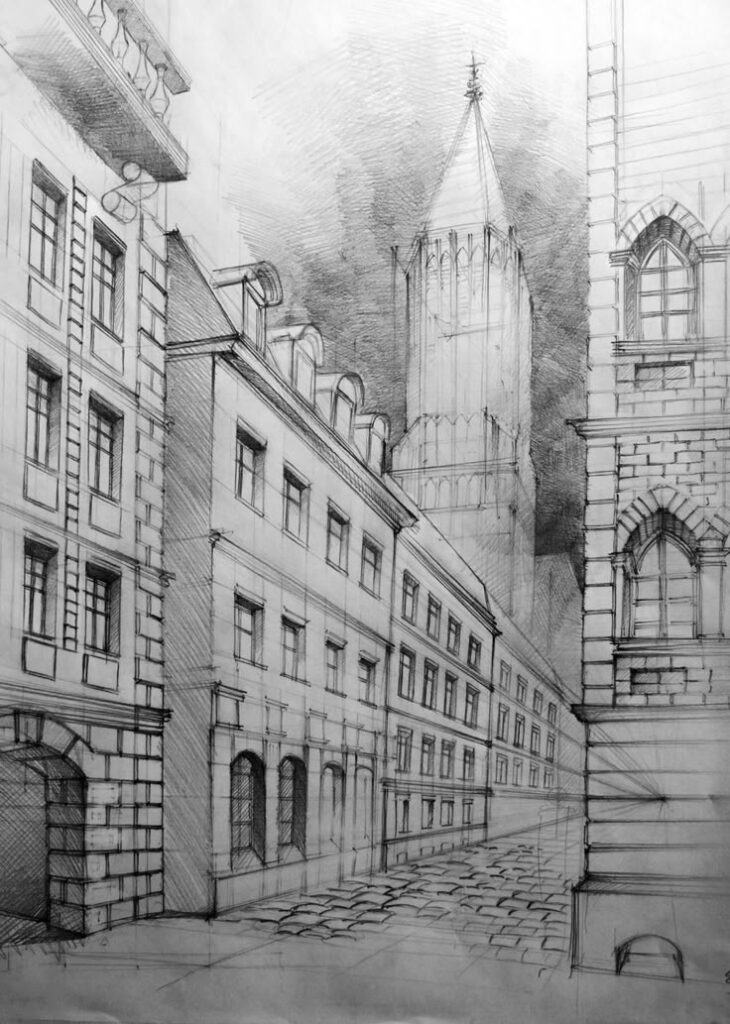
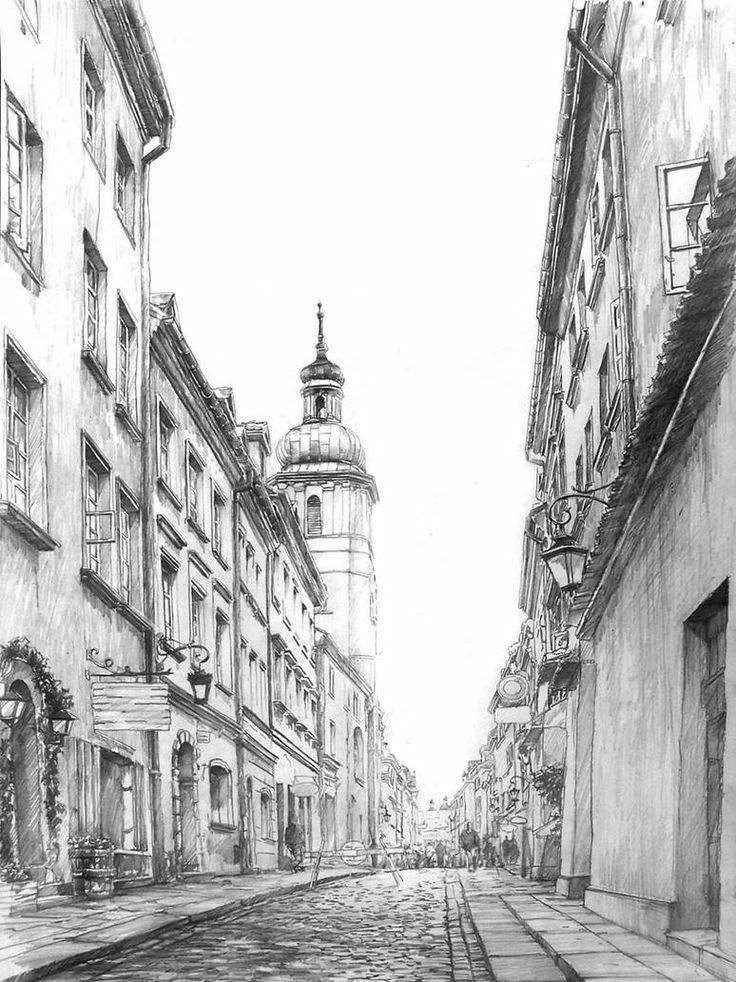
Applying Watercolor Techniques to Urban Sketches
Watercolor brings life and energy to urban sketches through strategic washes, controlled layering, and thoughtful color mixing. Success depends on understanding water-to-pigment ratios and working with the medium’s natural flow characteristics.
Fundamental Watercolor Methods
Wet-on-wet technique creates soft, atmospheric effects perfect for sky washes and distant buildings. Apply clean water to your paper first, then drop pigment into the wet surface. The paint will spread naturally, creating organic edges ideal for clouds or background elements.
Wet-on-dry gives you precise control for architectural details. Paint directly onto dry paper to achieve sharp edges and defined shapes. This method works well for building outlines, windows, and structural elements.
Control your water-to-pigment ratio carefully. More water creates transparent washes for backgrounds. Less water produces intense color for focal points. Test your mixture on scrap paper before applying to your sketch.
Graduated washes help establish depth in urban scenes. Start with concentrated pigment at the top, gradually adding water as you move downward. This technique works effectively for sky gradients and building shadows.
Line and Wash Techniques
Combine pen and ink with watercolor for dynamic urban sketches. Complete your line drawing first using waterproof ink, then add watercolor washes over the dried linework.
Selective line work creates visual interest. Leave some areas as pure watercolor while defining others with ink. This approach prevents your sketch from appearing overworked.
Use varying line weights to establish hierarchy. Thick lines for foreground elements, thin lines for background details. The watercolor will enhance these relationships through color temperature and value contrasts.
Negative space painting defines architectural forms without outlining every edge. Paint around building shapes to create clean, geometric forms. This technique works particularly well for modern urban structures.
Creating Mood and Atmosphere
Color temperature establishes time of day and weather conditions. Warm colors (reds, oranges, yellows) suggest sunrise, sunset, or artificial lighting. Cool colors (blues, purples, greens) indicate overcast conditions or shadows.
Atmospheric perspective creates depth through color shifts. Paint distant buildings with cooler, lighter colors. Foreground elements should use warmer, more saturated hues.
Value contrast guides the viewer’s eye through your composition. Reserve your darkest darks and lightest lights for focal areas. Mid-tones should dominate the supporting elements.
Weather effects enhance urban atmosphere. Light washes of blue-gray suggest overcast skies. Warm amber tones indicate golden hour lighting. Purple shadows create evening moods.
Layering and Color Harmony
Transparent layering builds complex colors gradually. Allow each layer to dry completely before adding the next. This prevents muddy mixtures and maintains color clarity.
Color mixing occurs in three ways: palette mixing, wet-in-wet blending, and optical mixing through transparent layers. Each method produces different effects and textures.
Complementary colors create vibrant contrasts. Orange and blue work well for sunset scenes. Red and green enhance natural elements against urban backgrounds.
Analogous color schemes produce harmonious results. Use colors adjacent on the color wheel for subtle, sophisticated paintings. Blue-green-purple combinations work well for twilight urban scenes.
Lifting techniques remove paint while wet to create highlights and textures. Use clean, damp brushes or paper towels to lift pigment from wet washes.
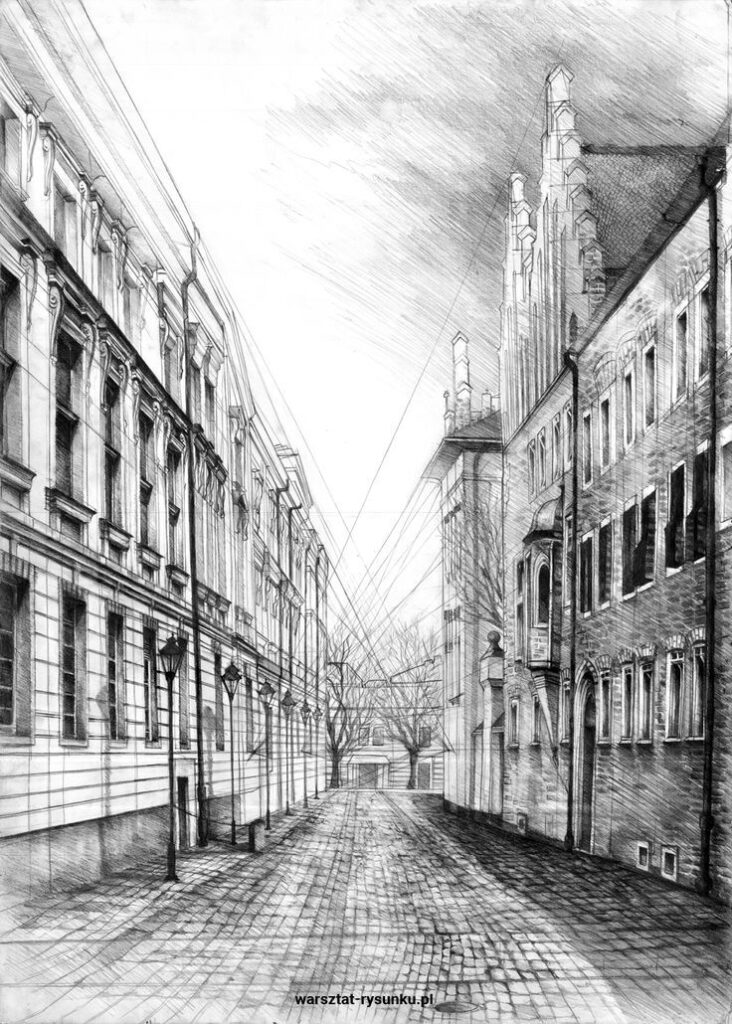
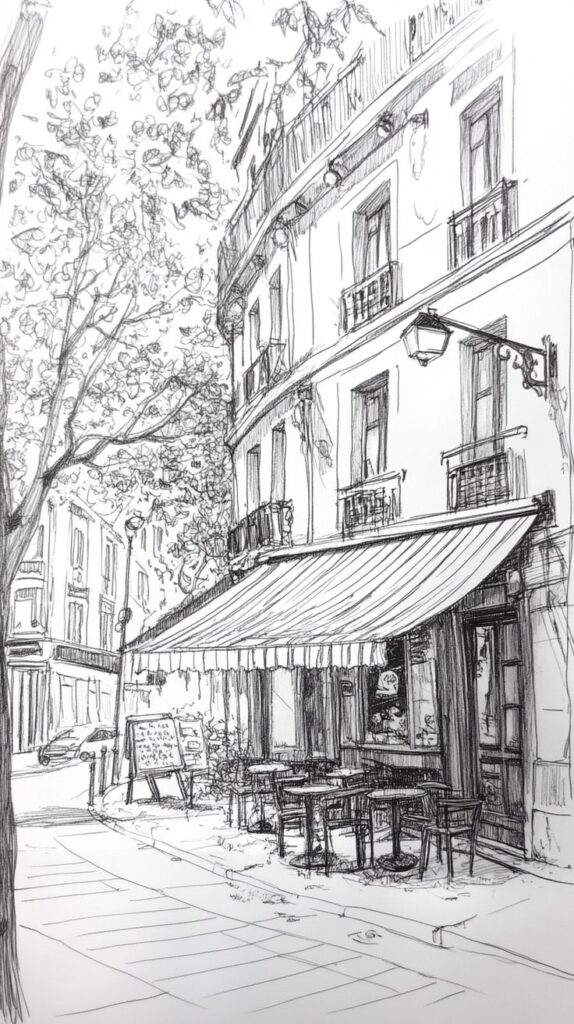
Exploring Urban Sketching Styles and Composition
Urban sketching encompasses diverse artistic approaches that range from loose watercolor washes to detailed architectural drawings. Mastering composition principles like perspective and focal points helps transform busy cityscapes into compelling visual narratives.
Popular Urban Sketching Styles
Loose Watercolor Style captures atmospheric qualities through fluid brushwork and color bleeding. This approach prioritizes mood over precision, letting paint flow naturally to suggest building textures and weather conditions.
Detailed Line Work focuses on architectural accuracy using fine-tip pens or pencils. Urban sketchers who prefer this style document structural elements, window patterns, and decorative details with careful observation.
Mixed Media Approaches combine watercolor, ink, and colored pencils for versatility. You can establish structure with ink lines, add atmospheric washes with watercolor, and enhance details with colored pencils or markers.
Impressionistic Sketching emphasizes light, shadow, and movement over exact representation. This style works well for capturing busy street scenes where people and vehicles create dynamic compositions.
Composition and Perspective Tips
Rule of Thirds divides your sketch into nine equal sections using imaginary lines. Place focal points like prominent buildings or interesting architectural features along these lines rather than centering them.
Leading Lines guide the viewer’s eye through your composition. Streets, building edges, and sidewalks create natural pathways that draw attention to your main subject.
One-Point Perspective works effectively for street scenes where buildings recede toward a single vanishing point. This technique creates depth and makes viewers feel they’re standing in the actual location.
Two-Point Perspective handles corner views and building intersections more accurately. Urban sketchers use this method when depicting buildings from angles that show multiple facades.
Capturing Urban Stories
Street Activity brings life to architectural subjects through human elements. Include pedestrians, cyclists, and vendors to show how people interact with urban spaces.
Seasonal Changes document how weather and time affect city environments. Morning shadows, evening light, and seasonal decorations tell temporal stories within static architectural frameworks.
Cultural Details record unique neighborhood characteristics like shop signs, street art, and local architectural styles. These elements differentiate your sketches from generic city views.
Daily Rhythms capture different moods throughout the day. Rush hour energy, lunch break conversations, and evening quiet create distinct atmospheric qualities in the same location.
Balancing Detail and Simplicity
Selective Focus emphasizes important elements while simplifying backgrounds. Urban sketchers often render foreground subjects with sharp detail and suggest distant buildings with loose strokes.
Negative Space uses empty areas to balance busy urban compositions. Sky areas, building shadows, and open plazas provide visual rest between complex architectural elements.
Hierarchy of Detail establishes clear focal points through varying line weights and rendering intensity. Bold outlines define primary subjects while lighter marks suggest secondary elements.
Editing Decisions involve choosing which urban elements to include or omit. Successful sketches often eliminate distracting details like excessive signage or utility lines that don’t contribute to the main story.
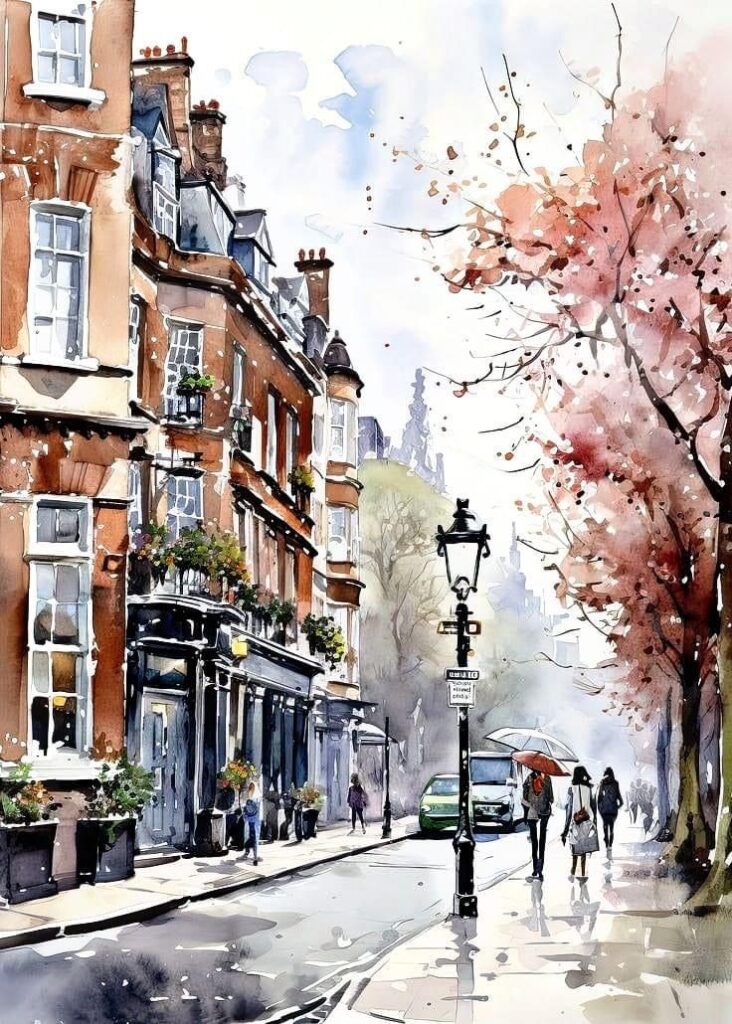
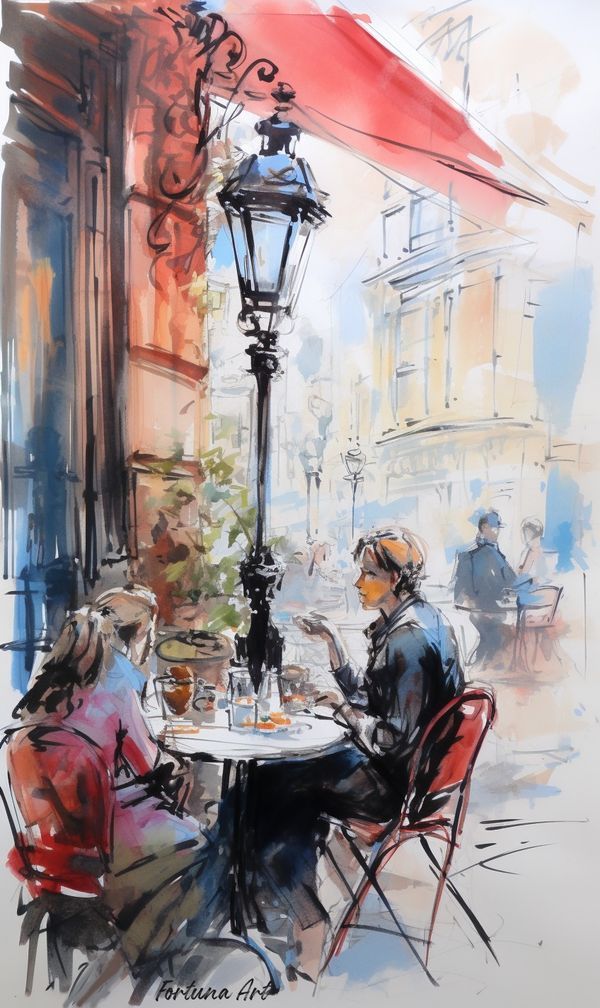
Building Skills and Joining the Urban Sketching Community
Developing your urban sketching abilities requires consistent practice and engagement with fellow artists. The urban sketching community offers structured activities and supportive networks that accelerate your artistic growth while providing opportunities to share your work with others.
Practicing Through Sketchcrawls
Sketchcrawls are organized drawing sessions where urban sketchers gather at specific locations to sketch together. These events typically last 2-3 hours and focus on capturing different aspects of urban environments.
You can find sketchcrawls through local Urban Sketchers chapters or art organizations in your city. Most groups welcome beginners and provide guidance on basic techniques.
Benefits of sketchcrawls include:
- Real-time feedback from experienced artists
- Exposure to different sketching styles and approaches
- Motivation to complete sketches within set timeframes
- Access to locations you might not visit alone
During sketchcrawls, you’ll work in your sketchbook while observing how others approach the same scenes. This direct learning experience helps you develop faster than practicing alone.
Many sketchcrawls end with a “show and tell” session where participants share their work. This builds confidence and provides immediate constructive feedback.
Learning from Urban Sketching Groups
Urban Sketchers groups exist in cities worldwide and offer structured learning opportunities beyond casual sketchcrawls. These communities provide workshops, demonstrations, and ongoing support for artists at all skill levels.
Local groups often host monthly meetings with guest instructors who teach specific techniques like perspective drawing, color mixing, or architectural details. You can access these resources through online platforms and local meetup groups.
Key learning opportunities include:
- Technique-focused workshops
- Critique sessions for skill improvement
- Access to experienced mentors
- Collaborative projects and challenges
Online Urban Sketchers communities complement local groups by providing global perspectives and techniques. You can learn from international artists who sketch different urban environments and cultural settings.
Many groups maintain libraries of reference materials and technique guides that members can access. These resources help you develop skills between group meetings.
Sharing Your Work
Sharing your urban sketching work builds confidence and connects you with other artists who provide valuable feedback. Most urban sketchers share their work through social media platforms, personal blogs, or community websites.
Effective sharing strategies:
- Post regular sketches with location details
- Include brief descriptions of your techniques
- Engage with other artists’ work through comments
- Participate in online sketching challenges
Your sketchbook becomes a visual diary of your urban experiences when shared consistently. This documentation helps you track your progress and identify areas for improvement.
Many Urban Sketchers groups organize exhibitions where members display their work publicly. These events provide exposure to broader audiences and validate your artistic development.
Consider joining online forums dedicated to urban sketching where you can ask questions and share techniques with artists worldwide. These platforms offer immediate feedback and continuous learning opportunities.
- 127shares
- Facebook0
- Pinterest127
- Twitter0
